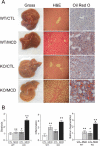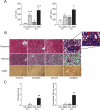Liver-specific beta-catenin knockout mice exhibit defective bile acid and cholesterol homeostasis and increased susceptibility to diet-induced steatohepatitis
- PMID: 20019186
- PMCID: PMC2808081
- DOI: 10.2353/ajpath.2010.090667
Liver-specific beta-catenin knockout mice exhibit defective bile acid and cholesterol homeostasis and increased susceptibility to diet-induced steatohepatitis
Abstract
Although the role of Wnt/beta-catenin signaling in liver growth and development is well established, its contribution in non-neoplastic hepatic pathologies has not been investigated. Here, we examine the role of beta-catenin in a murine model of diet-induced liver injury. Mice with hepatocyte-specific beta-catenin deletion (KO) and littermate controls were fed the steatogenic methionine and choline-deficient (MCD) diet or the corresponding control diet for 2 weeks and characterized for histological, biochemical, and molecular changes. KO mice developed significantly higher steatohepatitis and fibrosis on the MCD diet compared with wild-type mice. Both wild-type and KO livers accumulated triglyceride on the MCD diet but, unexpectedly, higher hepatic cholesterol levels were observed in KO livers on both control and MCD diets. Gene expression analysis showed that hepatic cholesterol accumulation in KO livers was not attributable to increased synthesis or uptake. KO mice had lower expression of bile acid synthetic enzymes but exhibited higher hepatic bile acid and serum bilirubin levels, suggesting defects in bile export. Therefore, loss of beta-catenin in the liver leads to defective cholesterol and bile acid metabolism in the liver and increased susceptibility to developing steatohepatitis in the face of metabolic stress.
Figures







References
-
- Willert K, Nusse R. Beta-catenin: a key mediator of Wnt signaling. Curr Opin Genet Dev. 1998;8:95–102. - PubMed
-
- Barker N. The canonical Wnt/beta-catenin signalling pathway. Methods Mol Biol. 2008;468:5–15. - PubMed
-
- Brantjes H, Barker N, van Es J, Clevers H. TCF: lady Justice casting the final verdict on the outcome of Wnt signalling. Biol Chem. 2002;383:255–261. - PubMed
Publication types
MeSH terms
Substances
Grants and funding
LinkOut - more resources
Full Text Sources
Medical
Molecular Biology Databases
Research Materials

